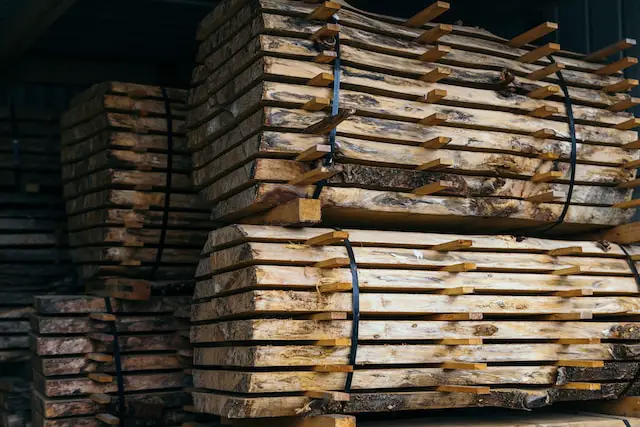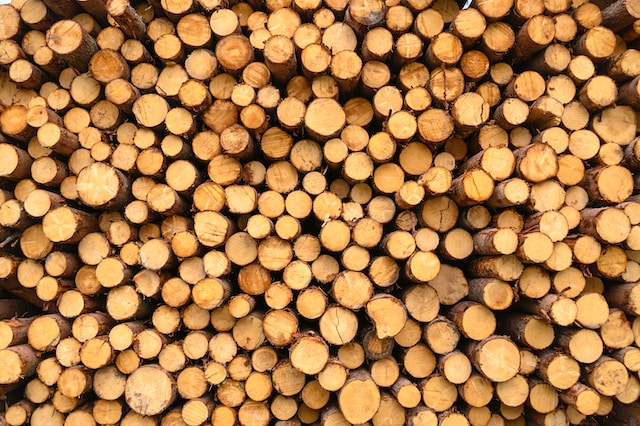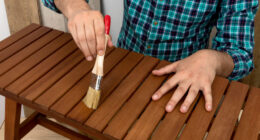Wood refers to the material that comes from trees, Timber specifically refers to wood that has been processed for construction or other purposes.
What is wood?

Wood is one of nature’s most versatile and extraordinary materials. Derived from the stems and branches of trees, wood has been used for centuries in various applications – from constructing shelters to crafting intricate furniture pieces.
Wood is composed of tiny fibers called cellulose that provide strength and stability. It also contains lignin, a substance that gives wood its unique color and durability. The beauty of wood lies not only in its natural variations but also in its ability to be shaped and transformed into different forms.
Wood can be classified into two main types: hardwood and softwood. Hardwood comes from deciduous trees like oak or maple, known for their density and resistance to wear. On the other hand, softwood originates from coniferous trees such as pine or cedar, which are typically lighter and easier to work with.
What is timber?

Timber, a term commonly used in the construction industry, refers to wood that has been prepared for use in building structures or other purposes. It is derived from trees and is processed to remove bark and branches, resulting in a sturdy material suitable for various applications.
The process of turning raw wood into timber involves drying it thoroughly to reduce moisture content. This reduces the likelihood of warping or shrinking once it is incorporated into structures. Additionally, timber may be treated with preservatives to prevent decay caused by insects or fungi.
Wood Vs. Timber – Key differences
| Wood | Timber |
|---|---|
| Refers to the fibrous structural tissue found in the stems | Refers to processed wood that is suitable for construction |
| Obtained from trees and shrubs | Derived from harvested logs |
| Used in various applications, including furniture and crafts | Primarily used in construction and structural applications |
| Can be used as raw material or undergo various treatments | Typically processed and prepared for specific applications |
| Comes in various sizes and shapes | Cut into standard sizes, such as beams, planks, and boards |
| Varies based on the type and density of wood | Typically selected for its strength and structural integrity |
| May or may not undergo grading systems | Often graded based on quality and structural properties |
| May have higher moisture content | Typically kiln-dried to reduce moisture and increase stability |
| Requires additional treatment for preservation | May be treated with preservatives for enhanced durability |
Types of wood
- Oak: Known for its strength and durability, oak is commonly used in furniture, flooring, and cabinetry.
- Pine: A softwood with a light color and grain pattern, pine is widely used for construction, interior trim, and furniture-making.
- Mahogany: Highly valued for its rich, reddish-brown color and grain, mahogany is often used in high-end furniture and decorative woodworking.
- Maple: Known for its light color and fine, even grain, maple is frequently used in flooring, cabinetry, and musical instruments.
- Walnut: Prized for its dark brown color and attractive grain, walnut is popular for furniture, cabinetry, and decorative veneers.
- Cherry: A hardwood with a reddish-brown color that darkens with age, cherry wood is favored for furniture, cabinets, and woodworking projects.
- Birch: A versatile hardwood with a pale color and smooth grain, birch is commonly used for furniture, cabinetry, and plywood.
- Ash: A light-colored hardwood, ash is appreciated for its strength and flexibility. It is often used in furniture, flooring, and sports equipment.
- Cedar: A softwood known for its natural resistance to decay and insects, cedar is frequently used for outdoor applications like decking, siding, and fences.
- Teak: Renowned for its durability and resistance to moisture, teak is popular for outdoor furniture, boat decks, and flooring.
Characteristics of good timber
Durability:
Good timber is known for its strength and ability to withstand various weather conditions without deteriorating quickly. It should have a long lifespan, making it ideal for construction purposes.
Stability:
High-quality timber has minimal shrinkage or expansion, which means it remains stable even when exposed to changes in humidity or temperature. This makes it suitable for furniture making and other applications where stability is crucial.
Resistance to pests and decay:
Good timber possesses natural properties that make it resistant to insects, fungi, and other organisms that can cause decay or damage. This ensures the longevity of structures made from this type of wood.
Straight grain:
Timber with straight grain patterns is highly valued due to its aesthetic appeal and ease of working with tools during carpentry projects.
Density:
The density of good timber determines its strength and durability. Dense woods are more resistant to wear and tear, making them suitable for heavy-duty applications such as flooring or outdoor decking.
Moisture content:
Ideally, good timber should have an appropriate moisture content level that prevents warping or splitting while allowing for easy drying if necessary.
Stainability:
Some types of timber have beautiful natural colors that can be enhanced through staining or finishing processes while maintaining their integrity.
Image Credits
Featured Image By – Etienne Girardet on Unsplash
Image 1 By – Lukasz Szmigiel on Unsplash
Image 2 By – Sarah Worth on Unsplash









